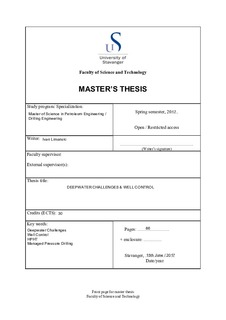| dc.description.abstract | Deepwater challenges and well control problems are important drilling issues, as operators move into deeper waters and more challenging environments. The deepwater technology and the complexity of deepwater operations have changed in the past years. To exploit deepwater hydrocarbon reserves, operators and contractors are working together to provide new technology, innovations and procedures to overcome most of the deepwater challenges.
This master thesis presents deepwater challenges and well control methods which are categorized into two major parts. The first section discusses deepwater challenges, environmental conditions, deepwater drilling facilities and deepwater field development. The second part discusses well control methods for deepwater drilling operations and high pressure, high temperature (HPHT) wells. Environmental conditions, hydrates, rig size, riser damage, well control problems, and drilling techniques are the major factors that affects drilling operations, production, day rates, drilling performance, efficiency, and cost of drilling operations.
Well control, to maintain a stable and safe well, is an important issue in deep water drilling operations. The main challenges in HPHT wells is hydrate formation, which results in plugging of pipelines and well control equipment. Also, narrow operating window between pore pressure and fracture pressure in deepwater fields is another major challenge. Some of the well control aspects presented in this section include kick causes, kick detection, kick tolerance, stuck pipe, surge and swab effects and the well kill procedures. Drillbench software is used to demonstrate well control behavior in HPHT conditions by analyze kick circulation out from the well. A comparison is made between a kick circulation with oil-based mud and water-based mud in HPHT wells.
The main goals of the operators are to achieve an optimal well control, increase access to deepwater reserves, improve wellbore integrity, reduce drilling costs and protect environments. With managed-drilling concepts, drillers can safely drill through narrow margins and reach target depths with a few casings. | nb_NO |
